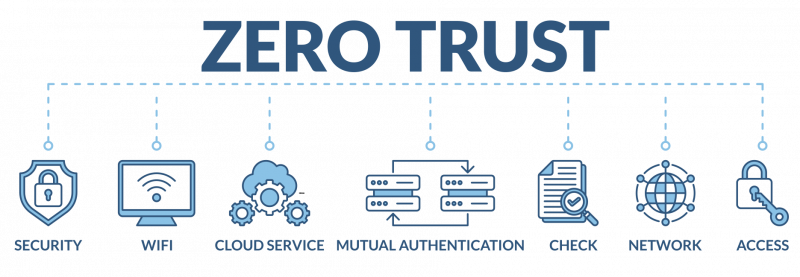Zero Trust
Unlike the implicit trust granted to users in the perimeter-based model, Zero Trust reduces this implicit trust by requiring regular, dynamic, and granular controls for resource access.
Faced with technological advancements such as cloud computing and remote work, Zero Trust challenges the implicit trust granted to users and offers a dynamic approach based on rigorous controls over resource access. This transformation aims to strengthen security against growing threats, integrating principles such as the principle of least privilege, continuous and granular controls.

Core Principles
The fundamental principles of Zero Trust challenge the traditional implicit trust in computer security models. Unlike conventional approaches that assume the reliability of users and devices within the network, Zero Trust adopts a default posture of distrust. Thus, every request for access to resources must be verified and authorized, regardless of the user’s or device’s position in the network. This fundamental change is based on several key principles, such as the need to know and least privilege. The need to know implies that access to resources is granted based on the specific requirements of a user or device to perform a particular task. Complementarily, least privilege dictates that access rights should be limited to the bare minimum, thereby reducing the potential attack surface.

In the context of Zero Trust, access controls extend beyond initial authentication but are continuous, dynamic, and granular. This approach ensures constant verification throughout the access session, taking into account various attributes such as user identity, resource sensitivity, and user behavioral analysis (UBA). The uniformity of controls is another essential principle, stipulating that security rules should be applied consistently, regardless of the origin of the access request. Furthermore, access policy should be dynamic, scalable, and regularly reassessed to adapt to changes in the IT environment, ensuring an agile response to evolving threats and organizational needs.
Implementation of a Zero Trust Strategy
The implementation of a Zero Trust strategy requires a comprehensive approach addressing five essential components within the security ecosystem.
The first crucial component is that of users, requiring appropriate authentication of individuals or entities seeking access. The diversity of access requests entails the implementation of different levels of authentication and tailored verifications to access specific functionalities. Managing this component requires regularly reassessing access rights, taking into account various attributes such as user identity, the sensitivity of requested resources, user behavioral analysis, and access schedules.
The dimension of devices in the Zero Trust strategy is equally crucial, requiring risk management related to devices used for access. Device attributes, such as access history to applications, user-device compliance, and security hygiene measures, play a decisive role in access rights decisions. Continuous analysis of these factors allows evaluating the level of trust granted to a specific device, thus influencing access permissions to various applications.
Applications are an integral part of the Zero Trust architecture, necessitating a secure connection between users and applications. A key element is the necessity for organizations to have a comprehensive application catalog containing essential information such as data sensitivity and network protocols used by these applications. This catalog forms the basis for effective access management, enabling a thorough risk assessment and consistent application of Zero Trust principles. It also ensures increased visibility into the application landscape, facilitating the implementation of access controls tailored to each application based on its specificities.
The dimension of data in the Zero Trust model plays a fundamental role in protecting sensitive information. It is recommended to incorporate specific data characteristics into the process of determining user rights. Data classification becomes a key element for the application of granular access control policies. Thus, highly sensitive data, such as financial or personal data, can benefit from higher protection levels, thereby enhancing overall system security and compliance.
The environment in the context of the Zero Trust model is of paramount importance, highlighting the need for segmentation to ensure an effective security architecture. While macro-segmentation, ensured by firewalls, establishes general boundaries, micro-segmentation becomes essential to secure internal enterprise networks. This approach delineates access zones, limiting potential lateral movements of threats and enhancing system resilience against internal and external attacks.


